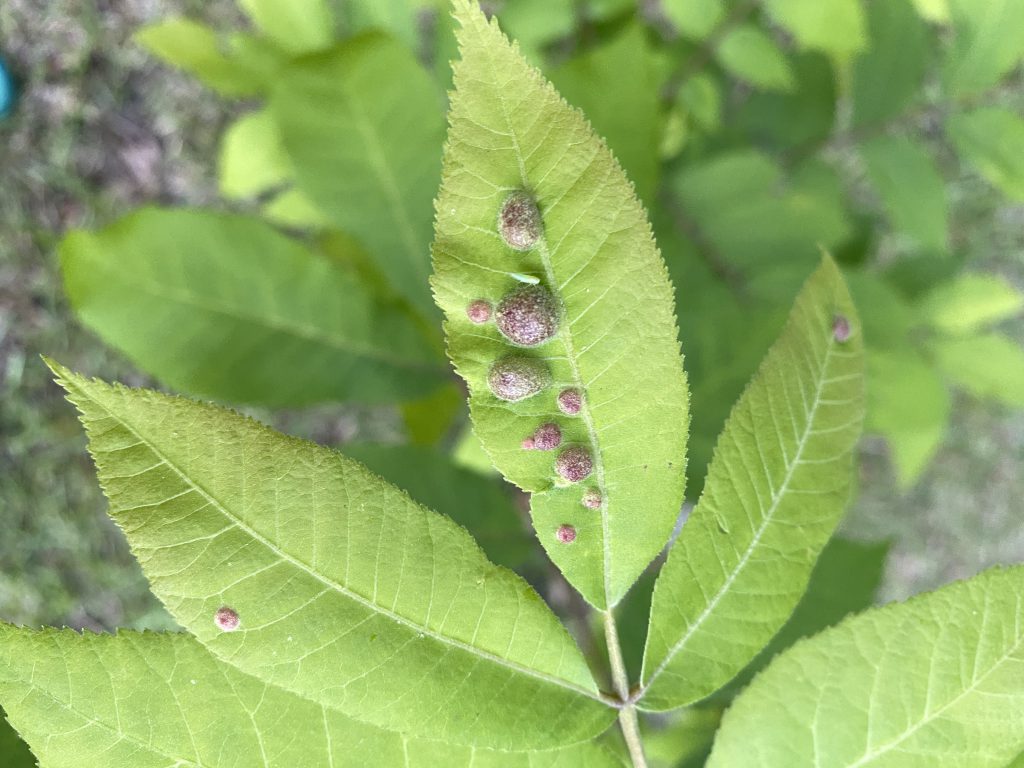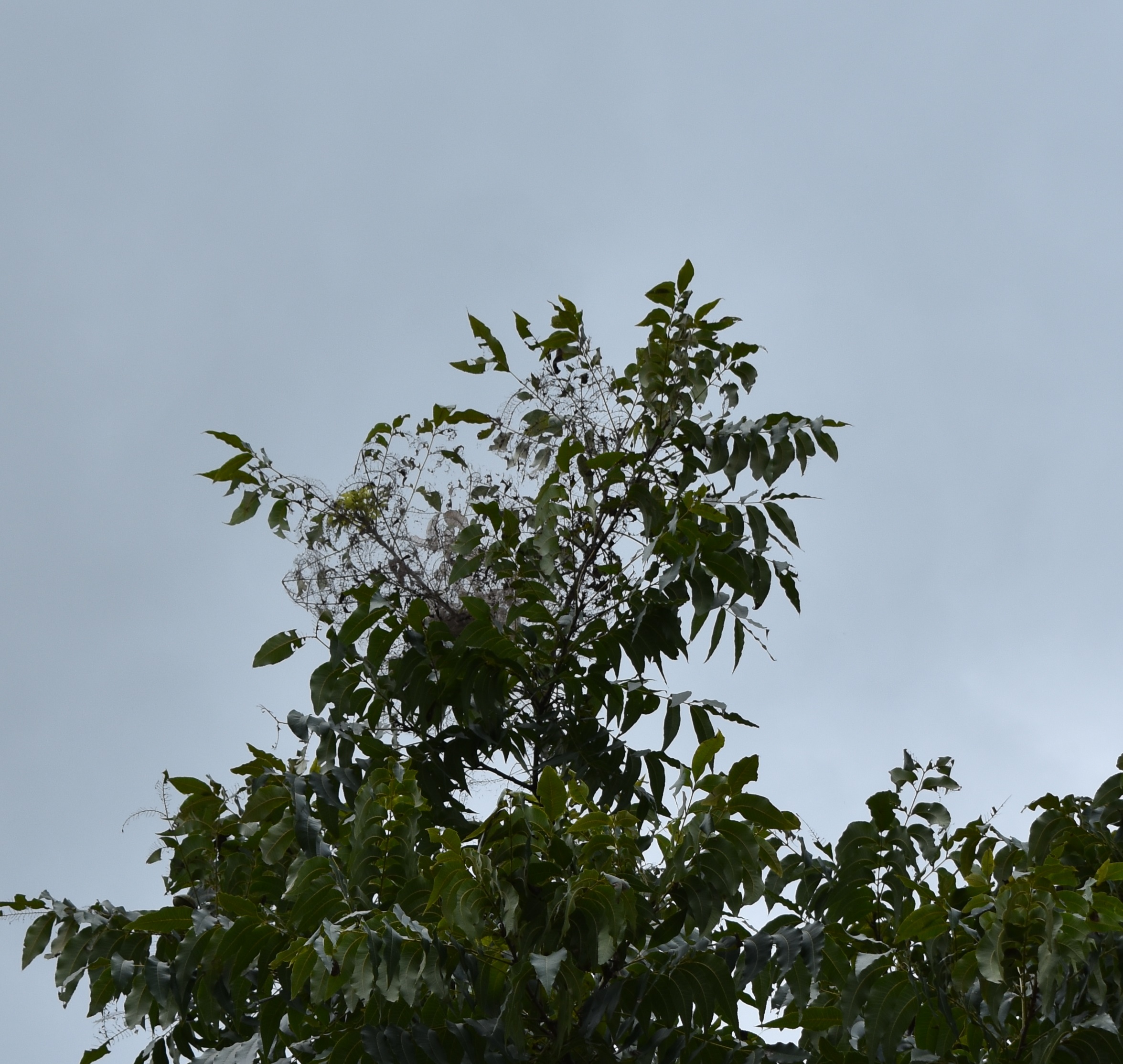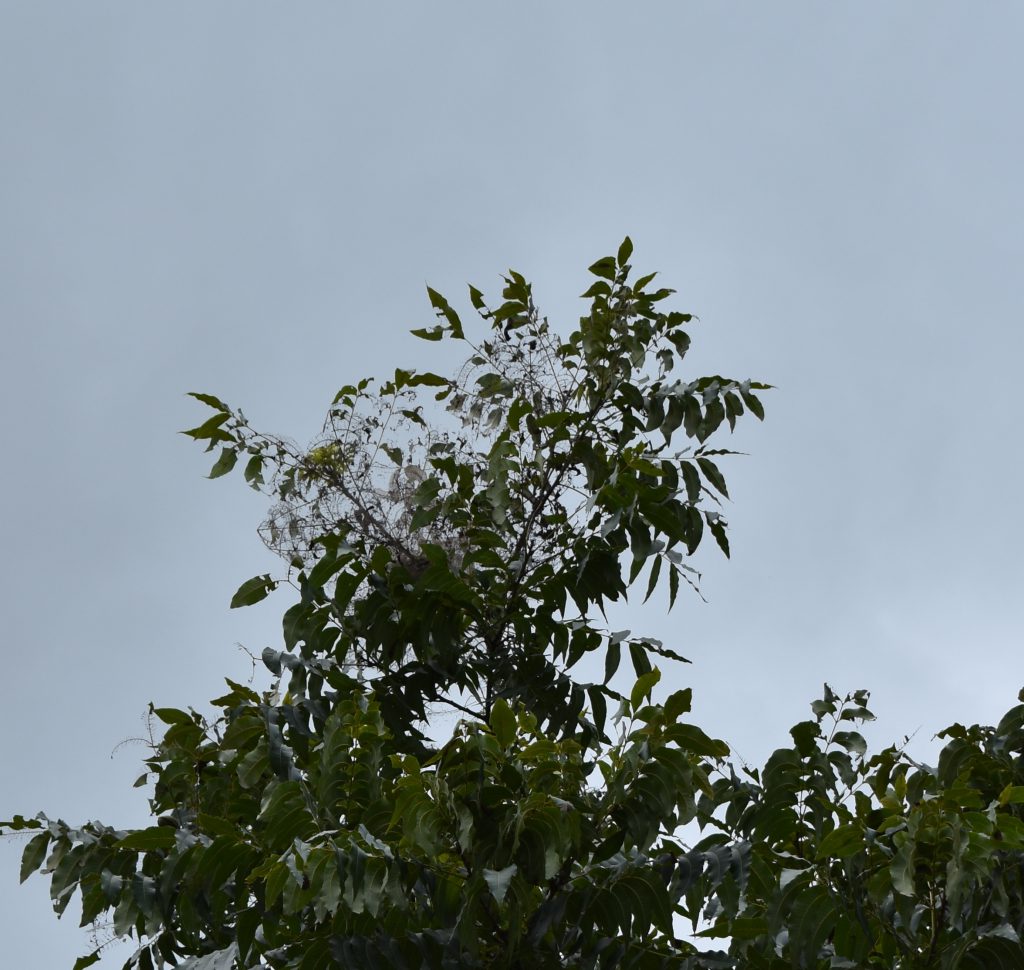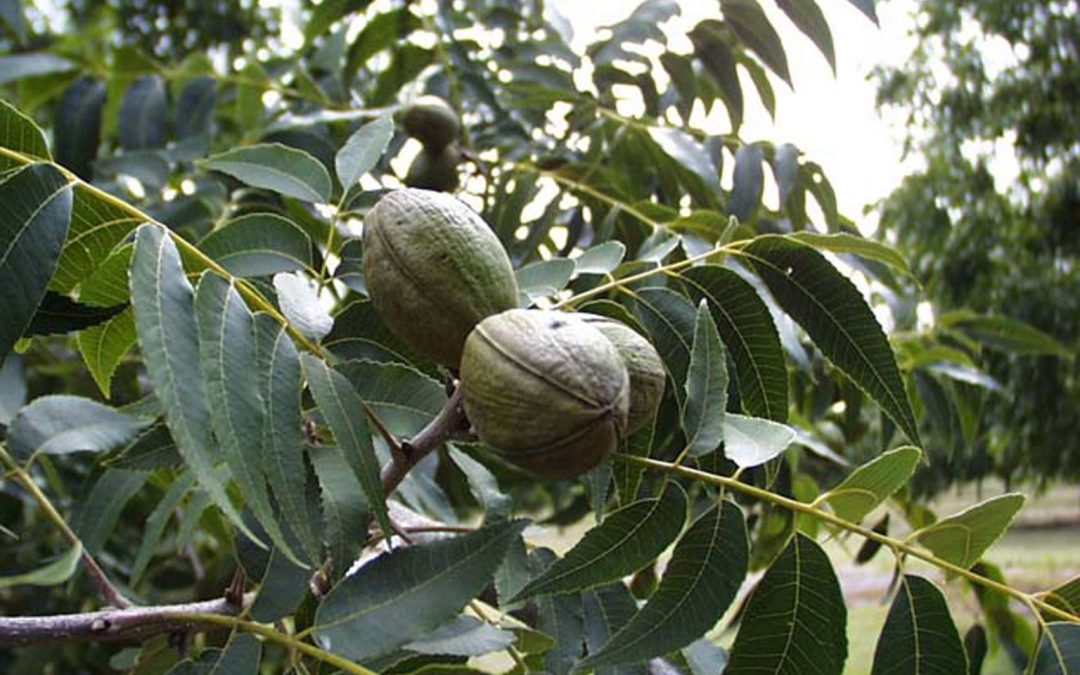
by Matt Lollar | Apr 23, 2020
I was recently sent some pictures of some unusual growths on pecan tree leaves. At first glance, the growths reminded me of the galls caused by small wasps that lay their eggs on oak leaves. However, after a little searching it became apparent this wasn’t the case. These galls were caused by the feeding of an aphid-like insect known as phylloxera.

Leaf galls caused by pecan phylloxera. Photo Credit: Matt Lollar, University of Florida/IFAS Extension – Santa Rosa County
The feeding from the phylloxera causes the young leaf tissue to become distorted and form a gall that encloses this female insect called a “stem mother”. These insects are rarely seen, but the hatch from over-wintering eggs in March/April just after budbreak. Once hatched, these “stem mothers” crawl to the new leaves and begin feeding. Once the gall forms, they start to lay eggs inside the gall. The eggs hatch inside the gall and the young phylloxera begin to feed inside the gall and the gall enlarges. The matured insects break out of the gall in May and some will crawl to new spots on the leaves to feed and produce more galls.

Pecan stem damage from phylloxera. Photo Credit: University of Georgia
There are two common species of phylloxera that infect the leaves. The Pecan Leaf Phylloxera seems to prefer young trees and the Southern Pecan Leaf Phylloxera prefers older trees. The damage from each of these insects is nearly indistinguishable. Damage from these insects is usually not severe and merely an aesthetic issue.
Once the damage is discovered on a tree, it is too late to control the current year’s infestation. There are currently no effective methods for control of phylloxera in home gardens. Soil drench applications witha product containing imidacloprid have been limited in their effectiveness.

by Matthew Orwat | Sep 13, 2018
Bare limb tips and clusters of webbing in pecan trees are often the first sign that fall is right around the corner.
This webbing is caused by clusters of the larvae of the Fall Webworm (Hyphantria cunea (Drury)) which is often also called Pecan Webworm. “Fall Webworm” is a bit of a misnomer in our region since they are able to strike in spring and summer thanks to our long growing season. They are most noticeable in the fall thanks to cumulative effects of earlier feeding.

The adult form of the fall webworm is a solid white or white and brown spotted moth that emerges in late March through August in southern climates. After mating they lay orderly clusters of green eggs, usually May through August. Soon after emergence, the larvae begin creating silk webs to protect themselves as they voraciously feed on their various host plants, of which Pecan is most common in Northwest Florida gardens.
Although they are capable of defoliating complete trees, especially smaller ones, most seasons they are kept in check by beneficial insects such as the paper wasp. It is beneficial for small orchards or home growers to scout their trees from June through August. If small webs are observed in young trees, it is best to prune them out with a pole saw or pole pruner and dispose of the branch. Pruning of small branches does not harm the tree, but it may be of no benefit to remove small webs in larger trees, if they are being controlled by natural enemies.
 Most home gardens don’t have a practical ability to spray for this insect. For homeowners it is difficult to spray for control, due to the cost of the equipment required to get the spray into the tree canopy. If spraying is an option, many insecticides containing spinosad or Bacillus thuringiensis (Bt) exist. Both of these products target caterpillars while not harming beneficial insect predators that feed on these worm populations. Several more toxic insecticide products exist that will control fall webworm, but they often exacerbate insect problems by killing off beneficial insects that might be controlling other insect pests.
Most home gardens don’t have a practical ability to spray for this insect. For homeowners it is difficult to spray for control, due to the cost of the equipment required to get the spray into the tree canopy. If spraying is an option, many insecticides containing spinosad or Bacillus thuringiensis (Bt) exist. Both of these products target caterpillars while not harming beneficial insect predators that feed on these worm populations. Several more toxic insecticide products exist that will control fall webworm, but they often exacerbate insect problems by killing off beneficial insects that might be controlling other insect pests.
Fall webworm is not usually a serious problem for home gardens. Let natural enemies take care of the problem in most cases.
Supplemental Material:

by Larry Williams | Jan 13, 2016
Pecan trees are well adapted to our area, making beautiful large shade trees. And, if the correct varieties are planted, they can provide pecans.
Only those pecan varieties that show some real resistance to disease problems are recommended for planting here in the humid south. Select grafted trees of Desirable, Curtis, Elliott, Moreland or Stuart varieties.

Pecan leaves and fruit. Photo credit: Brad Haire, University of Georgia, Bugwood.org
Obtain and plant your pecan trees during the winter – December through February. Purchase trees that are three to six feet tall. Larger trees are more difficult to transplant.
Give pecan trees plenty of room to grow. The distance between trees should be approximately sixty feet because mature trees are quite large. Commercial producers sometimes use a closer spacing, primarily because they are using varieties that will bear at an earlier age. But most of those varieties do not have good disease resistance and still require pesticide spray at times. Homeowners will not have the needed equipment to spray a large pecan tree and the drift from such sprays would not be desirable around your home, so commercial varieties aren’t recommended for home plantings.
One of the keys to survival of a pecan tree is not allowing the root system to dry out before, during or after transplanting. Regular watering will be required for a period of at least six months or until the young tree is well established. The planting hole should be 18 to 24 inches wide and only as deep as the root system. Spread the roots so they are not matted together. The planting depth is critical. Place at such a depth that the uppermost root is at or near the soil surface. Excessively deep planting can result in eventual death of the tree.
When planting your tree, there is no need or advantage to using peat moss, compost, manure or other organic matter in the planting hole. Plant the tree in the native soil without amendments.
Do not fertilize when the tree is planted. Wait until May of the first year after planning to apply fertilizer.
Remember that pecan trees are large at maturity, with branches spreading 30 feet or so from the trunk. Also, because of the brittle limbs and failing nuts, it’s best not to plant these trees too near the home, driveway or sidewalk.
by Julie McConnell | Jul 1, 2014
Panhandle residents have seen caterpillars in abundance this June. One common visitor to pecan trees is the Walnut Caterpillar Datana integerrima. The walnut caterpillar has a very narrow host range and feeds only on trees in the Juglandaceae family which includes walnut, pecan, and hickory trees. They are sometimes seen on other plant material, but feeding on non-host plants is unlikely.
Walnut caterpillar feed on the leaves of host trees through several growth stages and molts until they have reached the final larval instar and are ready to pupate into an adult moth. Their color changes from light green when newly hatched to reddish-brown to almost black with long white hairs as they mature. The caterpillars group together in large masses and may hang from each other and dangle from the tree branches when molting. Instead of creating a cocoon in the tree, the walnut caterpillar moves to the ground beneath the tree and burrows into the soil or leaf litter to pupate and emerges later as a moth.
What can you do if your pecan tree is hosting walnut caterpillars?
Although the numbers seen on trees may be alarming, a healthy tree can tolerate some feeding damage. Stripped branches may increases the chance of a lower yield of fruit because the removal of leaves does reduce the amount of energy the tree can produce, but overall health of the tree should not be significantly affected. However, many homeowners find falling caterpillars and their excrement unappealing and may decide to take steps to manage the population.
There are several natural enemies that feed on caterpillars, so avoid using a broad spectrum insecticide that might harm predatory insects and other animals. Consider using a biological control product such as Bt (Bacillus thuringiensis) that is only lethal to caterpillars. Other methods are “pick and squish” or drowning in a bucket of soapy water. Next year, in the spring, watch for masses of tiny green eggs on the underside of leaves and remove and destroy them before hatching.
For more information visit USDA Forest Service Forest Insect & Disease Leaflet 41 “Walnut Caterpillar”
by Matthew Orwat | Aug 19, 2013
Florida Pecan Field Day and Florida Pecan Growers’ Association Annual Meeting
Jefferson County Extension Office 2729 West Washington Street
Monticello, Florida 8:30 AM, EDT
Thursday September 5th
 Harvest time is coming for Florida pecan growers. Demand is up, irrigation needs are down, and fungus pressure has been a serious problem over the entire Southeast.
Harvest time is coming for Florida pecan growers. Demand is up, irrigation needs are down, and fungus pressure has been a serious problem over the entire Southeast.
Producers will meet in Monticello on Thursday, September 5 for the annual field day and Pecan Growers’ Association meeting. If you’re a pecan grower, or just considering it, the morning’s topics and speakers will be a great opportunity to learn more about the pecan business.
The agenda is below. For more information, contact Jed Dillard at 850-342-0187
 or dillardjed@ufl.edu. Please make a lunch reservation by noon Tuesday, September 3.
or dillardjed@ufl.edu. Please make a lunch reservation by noon Tuesday, September 3.
Agenda-
- 8:30 Registration
- 9:00 Welcome……… Mark Brown, President Florida Pecan Growers Association and Jed Dillard, Jefferson County Extension Agent
- 9:10-9:45 “Florida Water Policy and Its Impending Effects on Pecan Production” ……. Carlos Herd, Director Division of Water Supply, Suwannee River Water Management District
- 9:45-10:15 “Management strategies and tactics for suppression of pecan arthropod pests: chemicals, trap crops and everything in between.”
- Dr. Russ Mizell, University of Florida Entomologist, Quincy
- 10:05-10:35 “Controlling scab and other pecan diseases” Dr. Tim Brenneman University of Georgia Department of Plant Pathology
- 10:35-10:55 Break
- 10:55-11:25 “Tree Spacing, Alternate Tree Pruning and Removal, and Tree Transplanting”. Dr. Lenny Wells, UGA Extension Pecan Specialist, Tifton
- 11:25- Noon “Direct Marketing of Pecans – What do I need to Know?”…………..Elena Toro, Suwannee County Extension Agent
- Noon…………… Sponsored Lunch
- 1PM Annual Meeting Florida Pecan Growers’ Association
- 1:15 Tour (Tentative)
- CEU’s: two half ceu’s for ag row crop, tree nut, private applicator and demonstration categories









